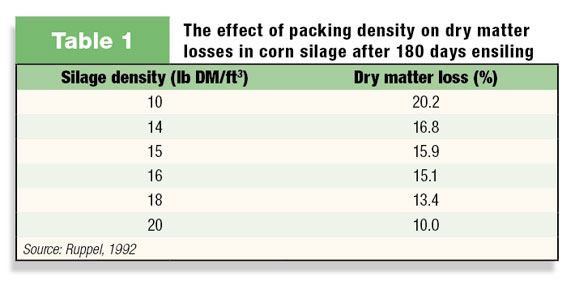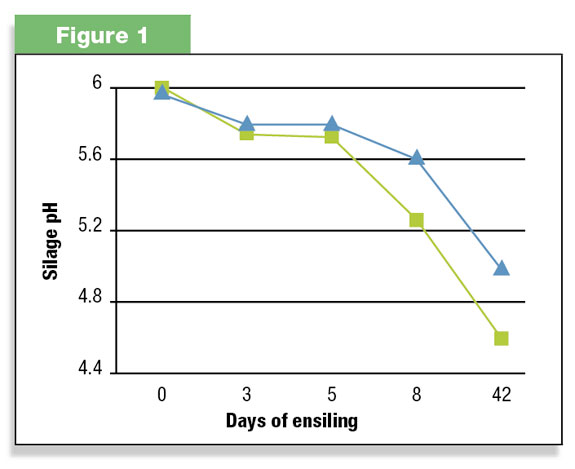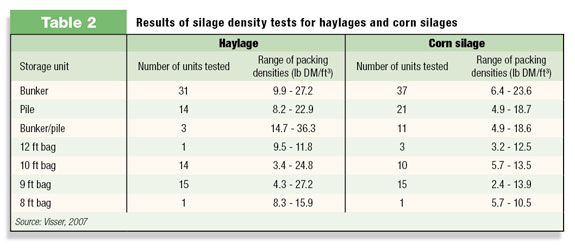Acidification is achieved, either in part or in total, by the production of organic acids from microbial fermentation within the ensilage (the ensiled material).
Microbes, or bacteria, either naturally occurring in the crop or applied as an inoculant, convert fermentable substrates, predominantly sugars, into organic acids that reduce the pH and effectively pickle the crop, producing acidified silage.
The most important acid produced, in terms of rapidly decreasing the pH, is lactic acid, though it is also advantageous to have some acetic and propionic acids produced, to achieve good stability of the material at feedout and to prevent heating and mold growth.
The bacteria that produce lactic acid in ensiled materials are facultative anaerobes, i.e., they can grow aerobically (with oxygen) and anaerobically (without oxygen), but produce lactic acid most efficiently in anaerobic conditions.
Thus, to reduce the pH as quickly as possible, to minimize nutrient losses and the potential for the fermentation to be overtaken by clostridia, it is important that the ensilage become anaerobic as quickly as possible.
Oxygen is the enemy, both in terms of achieving the desired fast initial fermentation to preserve the forage and for preventing spoilage after opening.
The importance of packing density
The process of harvesting fresh forage and placing into storage structures tends to aerate the forage (enabling oxygen to permeate the ensilage).
Rapid removal or displacement of this entrained oxygen is critical to achieve fast fermentation required to maintain quality in the resultant silage.
Left just in a loose, covered pile, oxygen would ultimately be utilized by the mixed microbial population in the forage at harvest, producing a rather smelly pile of composted material that would most likely turn clostridial once all the oxygen had been eliminated.

To ensure that good preserving fermentation is achieved and to minimize nutrient and dry matter losses, it is important to displace as much oxygen out of the ensilage mass as possible, by packing the material thoroughly and effectively. The effect of packing density on dry matter losses in silage is shown in Table 1.

In addition, Lynch and Kung showed that decreasing packing density resulted in a slower ensiling fermentation (Figure 1), which in turn influenced the level of yeasts in the silage at opening (>100 CFU yeasts/g in the more tightly packed silage compared to 100,000 CFU yeasts/g in the more loosely packed silage).
Managing packing density
The packing density achieved is a result of a number of factors, many of which can be controlled by the producer.

In a survey of 168 bunker silos in Wisconsin, Holmes and Muck found packing densities ranging from below 7 to just over 27 pounds DM per cubic foot and Visser reported a wide range of packing densities for corn silages and haylages in various structures from a survey that covered 177 storage units across Minnesota and Wisconsin (Table 2). Thus, it is clearly important to understand and manage the factors that can improve packing density.
The interrelationship between a number of the controllable management factors and the expected packing density can be explored using an excellent planning tool available on the University of Wisconsin website (www.uwex.edu/ces/crops/uwforage/storage.htm).
This link provides a “live” spreadsheet where the planned or actual values can be input by the producer or adviser and the resultant expected packing density will be automatically calculated.
By changing values in the spreadsheet, one can also see how adding weight to packing tractors, changing the delivery rate of the forage to the pit, etc., influences the final density achieved.
Producers are encouraged to go this website and juggle factors to discover the importance layer thickness plays in the whole ensiling process.
Factors that can be managed to achieve higher packing densities, which minimize nutrient and dry matter losses and enhance stability at feedout include:
1. Forage maturity/dry matter
Wetter forage compacts more easily, but can be prone to seepage and more likely to suffer a butyric fermentation (especially haylages).
Drier forage is more difficult to pack and keep compacted and is more likely to have higher levels of yeasts and molds (increased risk of instability at feedout).
2. Chop length and processing
Smaller particle size facilitates compaction, but needs to be balanced against feeding objectives.
3. Storage structure
In towers, gravity will take care of compaction of the material lower down in the tower, while the upper layers will not be adequately packed.
From previously given data, it is evident that good management of bagging machines is essential.
4. Forage delivery rate
This needs to be matched against optimum packing time/number of tractors, since it is often not practical to control delivery rate (especially if forage is harvested by a custom chopper).
5. Packing tractor weight
The estimated amount of packing weight required can be calculated by multiplying the estimated tons of crop delivered to the silo in an hour by 800.
Weights can be added directly to the front of the tractor or the three-point hitch or by filling tires with water.
6. Adding packing tractors
Optimally, packing time should be one to three minutes per ton of forage (fresh weight). It may take more than one packing tractor to achieve this without impacting the forage delivery rate.
7. Packing layer depth
Thinner is better, and the old rule of thumb of six inches as a maximum should really be applied.
8. Silo height
Greater height increases silage density in the lower layers, but for piles and bunkers this can lead to upper layers being less well-packed and can cause significant safety issues, both while filling and at feedout.
Bottom line
Achieving good packing density (minimum 15 lbs DM per cubic foot) is essential for making good-quality silage.
While the old mantra “pack, pack and pack some more” is a good rule of thumb, there are tools available to help producers plan and monitor the packing operation to achieve the best packing density. Putting those tools to work may have a positive effect on your bottom line. FG
References omitted due to space but are available upon request.
—Excerpts from The Saskatchewan Stockgrower, March 2008













